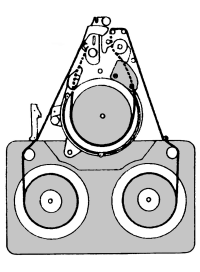The V2000 system was developed Philips to supersede their NV1500/1700 video
system. Perhaps the most widely known fact about the v2000 video system is that
it used a cassette which could be turned over allowing recording to be made on
both sides of the tape, just like an audio cassette tape. Video 2000 video
tapes were know as the Video Compact Cassettes and were modelled on the audio
Compact cassette which Philips had given to the world over twenty years earlier.
Like the Betamax and VHS systems, V2000 used 1/2 inch tape and a helical scan
system. The tape path was a M-wrap type with erase and audio heads placed
before and after the drum respectively.
| Basic V2000 System Data |
| Tape Width | 1/2 inch |
| Drum Diameter | 65.00 mm |
| Speed of Head Disc | 1500 rev/min |
| Video head to Tape Speed | 5.08 m/s |
| Tape Speed (PAL) | 2.44 cm/s |
| Video Head Gap | 0.4 microns |
| Audio Track Width | 0.65 mm |
| Audio Frequency Response | 50Hz - 10kHz |
| Cue Track Width | 0.325mm Defined
but not used! |
Maximum Recording Time
(PAL VCC-480) | 240mins per side |
| S/N Ratio | > 44dB CCIR 421-1 |
| Horizontal Resolution | 3 MHz < -20db |
| Angle of Video Tracks | 2o 6473 variable |
| End Sensors | Oprical (reflective) |
The feature made the V2000 format unique in its day was the absence of a
control track. This is a signal recorded along side the video tracks and
used to sync up the VCR during playback. Instead of this conventional approach
Philips took the initiative step of adding a selection of tones which were
recorded on the same track as the video signals themselves. These tones are then
picked up during playback and used to steer the video head tips so that they
remain on the correct path. The video head tips were able to move and so track
correctly by virtue of the fact that they were mounted on piezo-electric
crystals which were controlled by a varying voltage applied across them. It is
worth remembering that the capstan and drum servos of the early 1980's were not
very sophisticated as those we have today and so this extra movement was
essential to achieve satisfactory tracking. The feature was also able to provide
perfect noise free still and picture search by adjusting dynamically the angle
between the head and tape to compensate for the changes caused by the
variation in angle between the drum and the video tacks.
The end of tape detection is worthy of mention particularly for anybody
thinking of winding VHS tape into a V2000 shell. The end of tape detection was
achieved by an optical system which detected a reflective strip attached to the
inside of the tape at either end. Be sure to keep this strip if you spool in
new tape.
Although the V2000 format was not around long enough to have Hi-Fi audio
added to its specification VCRs were produced with linear stereo. The track
width was 0.25mm. Philips Dynamic Noise Suppression, DNS, was invented to
provide noise reduction and worked in a similar was as Sony's Beta Noise
Reduction, BNR.
A long play mode was also introduced albeit called XP for eXtended Play.
Like the other systems Long Play mode it doubled recording time by having the
linear tape speed. Sadly development of the format ceased before XP picture
search and still frame were implemented.

